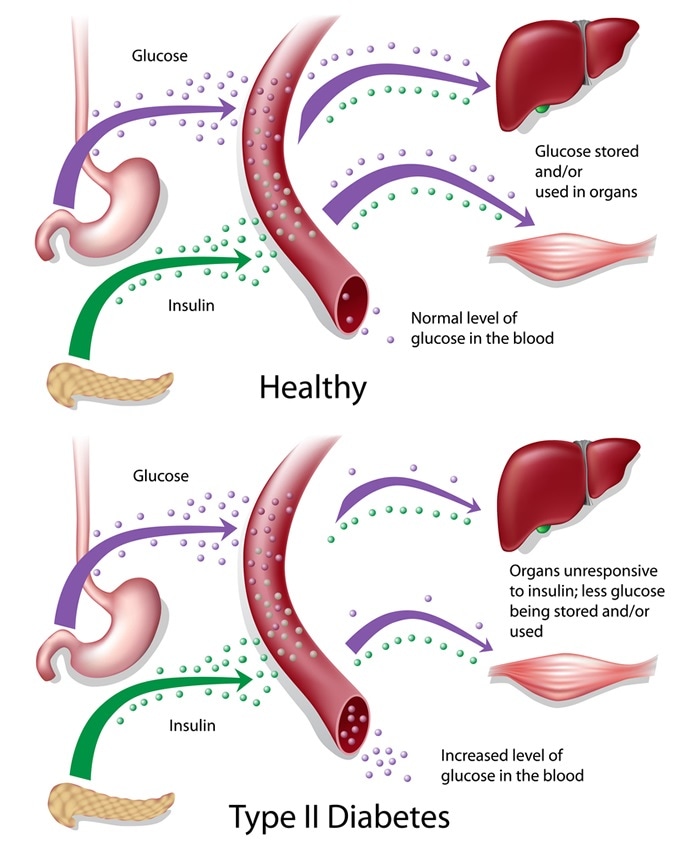There have been several studies that have connected excessive drinking to type 2 diabetes. However, there are no studies that have actually looked at the drinking patterns and frequency and diabetes.
Danish researchers have thus tried to understand the connection and explore if moderate alcohol consumption has a beneficial effect on diabetes. This new study was published this week in the journal Diabetologia.
This was a cohort study where the participants were followed up for a period of time. The data came from the Danish Health Examination Survey 2007–2008. The participants in the study were 28,704 men and 41,847 women – a total of 76,484. They were followed up for an average of 4.9 years. To look at their alcohol consumption patterns they were given questionnaires to fill.
The patterns noted included frequency of alcohol intake, frequency of binge indulgences, consumption of wine, beer and other spirits and their quantities.

Type 2 diabetes. Image Credit: Alila Medical Media / Shutterstock
Average alcohol consumption units were calculated for every person based on these to assess the weekly alcohol intake. Alongside the information of how many of these individuals developed diabetes was obtained from Danish National Diabetes Register.
Hazards of developing diabetes and its association with alcohol consumption were calculated using statistical tools and software.
Results showed that during the years of follow up of the participants, 859 men and 887 women developed diabetes.
The risk of development was lowest with those who reported consumption of 14 drinks/week among men and 9 drinks/week among women compared to people who did not take alcohol at all.
The risk of diabetes was significantly lower for those who took three to four drinks a week compared to those who took less than one drink a week.
Other factors that may influence the incidence of diabetes among the affected population were statistically adjusted for before coming to this conclusion.
According to experts, this study is by no means an advocate for increased alcohol consumption. Prof Janne Tolstrup, from the National Institute of Public Health of the University of Southern Denmark and lead researcher for this study said that drinking frequency was associated with diabetes incidence and not the quantity of alcohol consumed. It could be better to “drink the alcohol in four portions rather than all at once” she said.
Consuming alcohol three to four times a week thus reduced the risk of developing diabetes by 32% in women and 27% in men compared to those who drank once a week. Further not all types of alcohol could benefit. Wine, as has been found before, was found to be most beneficial because it contains more polyphenols.
Red wine in particular is beneficial in keeping blood sugar in control found the researchers. Men who took one to six beers a week had a 21% lower risk of diabetes compared to men who drank less than one beer a week.
There was no such effect of beer consumption among women. On the contrary women who drank more were at a greater risk of developing diabetes.
There was no connection between binge drinking and diabetes. Prof Tolstrup said this last bit could not be said with confidence as the number of binge drinkers were very few in the study.
Prof Tolstrup reiterated that alcohol is connected with several other serious disease conditions so this study is not a “go ahead” for consumption of excessive alcohol.
Some Definitions
A standard drink in the US has 14.0 grams or 0.6 ounces or 1.2 tablespoons of pure alcohol.
According to convention 12-ounces of beer has 5% alcohol, 8-ounces of malt liquor has 7% alcohol, and 5-ounces of wine 12% alcohol, 1.5-ounces of 80-proof distilled spirits or liquor such as rum, gin, vodka or whiskey has 40% alcohol content.
Binge drinking or heavy drinking is defined as 4 or more drinks for women and 5 or more drinks for men during a single occasion.
Heavy drinking means 8 or more drinks per week for women and 15 or more drinks per week for men. Moderate drinking as defined by Dietary Guidelines for Americans is up to 1 drink per day for women and up to 2 drinks per day for men.
References